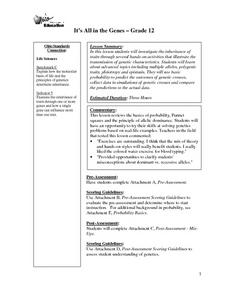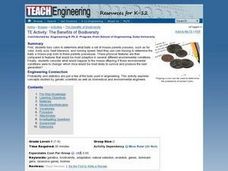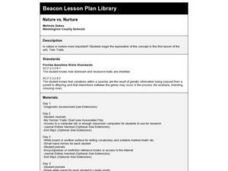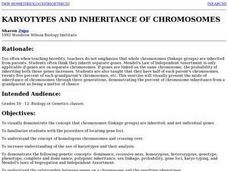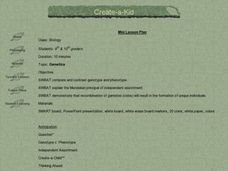Curated OER
Mendellian Genetics
Students describe the inheritance patterns other than simple dominance. They are taught how Mendel's principles apply to all organisms. Students review the use of Punnett Squares. They are taught the principles of probability and...
Curated OER
It's All in the Genes
Twelfth graders investigate the inheritance of traits through several hands-on activities that illustrate the transmission of genetic characteristics. Students study advanced topics including multiple alleles, polygenic traits,...
Curated OER
Disproving the Proof
Students investigate the progression of discoveries that have led to the genetics knowledge that scientists currently have. They determine how genetic experiments disproved previous theories on inheritance.
Curated OER
Monohybrid Punnetr Squares
Students explore Punnett squares and illustrate specific genotypic and phenotypic genetic outcomes. After a class discussion, students predict the probability of a specific trait being passed on by using Punnett squares. They reveal the...
Curated OER
Genes Count
Students view a video that reviews Mendelian genetics. They discuss the Hardy-Weinberg Law and use Popsicle sticks to simulate genetic variations and ratios in offspring.
Curated OER
Genes
Young scholars explore the history, inheritance and mutations of genetics. In this genetic lesson students complete experiments on DNA sequences.
Curated OER
Dihybrid Punnett Squares
Students construct Punnett squares to illustrate specific genotypic and phenotypic genetic outcomes.
Students calculate the probability of achieving specific genotypic and phenotypic genetic oucomes, using dihybrid Punnett squares.
Curated OER
Peanut Butter Broccoli
Fifth graders explore food production by viewing DNA presentations. In this genetic engineering lesson, 5th graders discuss the foods they typically eat at home and how many common foods are engineered in a way that can produce a bigger...
Curated OER
Nature And Nurture
Learners develop an understanding of the role both nature and nurture play in determining an individual's traits. Using a website, students answer questions about nature and nurture in order to solve the riddle, What do you call a smart...
Curated OER
The Benefits of Biodiversity
Students examine the concept of biodiversity. They toss coins to determine what traits mouse parents have and the babies traits as well. They predict what would happen to the baby mice if the traits of the parents were different.
Curated OER
Canine Companions
Students research and complete activities about dogs. In this dog activity, students read information about dogs to examine their traits, behavior, language, characteristics, and genetics. Students take a quiz about the information.
Curated OER
Population Study and Applications Using PTC Paper
Students study human population traits. In this science lesson plan, students gain an understanding of the terms dominant, recessive, haploid (monoploid), diploid, genotype, phenotype, scientific sampling, and scientific modeling as they...
Curated OER
Chromosomes
In this chromosomes instructional activity, students complete a crossword puzzle with 33 questions about genetic mutation in chromosomes. They identify traits associated with certain genes.
Curated OER
Breeding Bunnies
Learners learn the impact that genetics can have on the evolution of a population of organisms and become aware of the influence that the environment has onorganisms.
Curated OER
Observing First Impressions
Students explore their own personal qualities. For this social awareness lesson, students explore their identities as results of genetics and environments. Students also discuss first impressions and their reliability.
Curated OER
Who Are We? An Introduction to the Life Within Our Bodies
Students examine cell structure, cell division, and the basic structure of DNA. They read and discuss a case study of DNA research, answer discussion questions, role-play the process of mitosis, and complete a DNA Fact or Fiction worksheet.
Curated OER
The Theory of Evolution
In this theory of evolution learning exercise, students review vocabulary words associated with evolution including the different types of evolution patters. This learning exercise has 5 true or false and 5 matching questions.
Curated OER
Nature vs. Nurture
Eighth graders investigate the concept of nature versus nurture in human development through this series of lessons.
Curated OER
Genome Interactions
In this genome interactions worksheet, students read the passage about genome interactions then apply the knowledge to answer several short answer questions.
Curated OER
Karyotypes and Inheritance of Chromosomes
Students explore the mode of inheritance of chromosomes. Given a scenario, students use the Human Genome sheet to determine inherited chromosomes. They illustrate the difference between genotype and phenotype. Students develop a model...
Curated OER
Peanut Butter Broccoli
Young scholars explore selective breeding and genetic engineering. They illustrate that produce items have a wide variety of traits that can potentially be combined to produce a new food by creating a class graph.
Curated OER
Cotton and Cabbage
High schoolers note how given traits could be achieved by selective breeding and by transgenesis. They identify different uses of GEO. Students recognize that the use of letters (Bt) before an organism's name means that the organism has...
Curated OER
Karyotypes & Chromosome Inheritance
Students study Mendelian genetic terms, locate and name loci on chromosomes, karyotype construction, inheritance patterns through families.
Curated OER
Create-A-Kid
Students flip a pair of coins to determine what genotype and what phenotype their child have for 29 given traits. They draw a picture of their kid based on their coin flip phenotypes.
Other popular searches
- Genetic Traits Chart
- List of Genetic Traits
- Inherit Genetic Traits
- Pedigree Genetic Traits
- Genetic Traits in Families
- Ear Lobe Genetic Traits
- Genetic Traits and Dice
- Genetic Traits Single Gene
- Dna Genetic Traits
- Genetic Traits Hair Whorl
- Genetic Traits Activities
- Passing Genetic Traits



